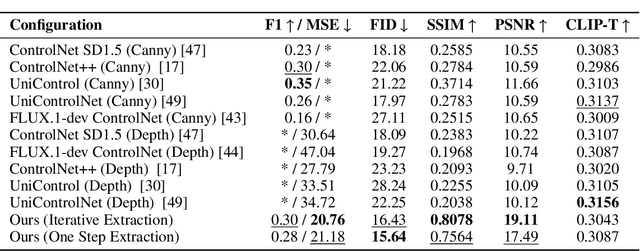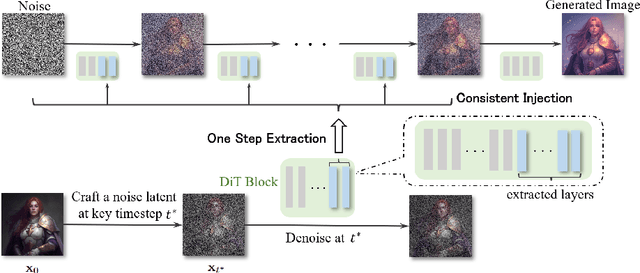Ye Wang
Perry
Spatial-Aware VLA Pretraining through Visual-Physical Alignment from Human Videos
Dec 15, 2025Abstract:Vision-Language-Action (VLA) models provide a promising paradigm for robot learning by integrating visual perception with language-guided policy learning. However, most existing approaches rely on 2D visual inputs to perform actions in 3D physical environments, creating a significant gap between perception and action grounding. To bridge this gap, we propose a Spatial-Aware VLA Pretraining paradigm that performs explicit alignment between visual space and physical space during pretraining, enabling models to acquire 3D spatial understanding before robot policy learning. Starting from pretrained vision-language models, we leverage large-scale human demonstration videos to extract 3D visual and 3D action annotations, forming a new source of supervision that aligns 2D visual observations with 3D spatial reasoning. We instantiate this paradigm with VIPA-VLA, a dual-encoder architecture that incorporates a 3D visual encoder to augment semantic visual representations with 3D-aware features. When adapted to downstream robot tasks, VIPA-VLA achieves significantly improved grounding between 2D vision and 3D action, resulting in more robust and generalizable robotic policies.
FreeControl: Efficient, Training-Free Structural Control via One-Step Attention Extraction
Nov 07, 2025



Abstract:Controlling the spatial and semantic structure of diffusion-generated images remains a challenge. Existing methods like ControlNet rely on handcrafted condition maps and retraining, limiting flexibility and generalization. Inversion-based approaches offer stronger alignment but incur high inference cost due to dual-path denoising. We present FreeControl, a training-free framework for semantic structural control in diffusion models. Unlike prior methods that extract attention across multiple timesteps, FreeControl performs one-step attention extraction from a single, optimally chosen key timestep and reuses it throughout denoising. This enables efficient structural guidance without inversion or retraining. To further improve quality and stability, we introduce Latent-Condition Decoupling (LCD): a principled separation of the key timestep and the noised latent used in attention extraction. LCD provides finer control over attention quality and eliminates structural artifacts. FreeControl also supports compositional control via reference images assembled from multiple sources - enabling intuitive scene layout design and stronger prompt alignment. FreeControl introduces a new paradigm for test-time control, enabling structurally and semantically aligned, visually coherent generation directly from raw images, with the flexibility for intuitive compositional design and compatibility with modern diffusion models at approximately 5 percent additional cost.
DemoGrasp: Universal Dexterous Grasping from a Single Demonstration
Sep 26, 2025Abstract:Universal grasping with multi-fingered dexterous hands is a fundamental challenge in robotic manipulation. While recent approaches successfully learn closed-loop grasping policies using reinforcement learning (RL), the inherent difficulty of high-dimensional, long-horizon exploration necessitates complex reward and curriculum design, often resulting in suboptimal solutions across diverse objects. We propose DemoGrasp, a simple yet effective method for learning universal dexterous grasping. We start from a single successful demonstration trajectory of grasping a specific object and adapt to novel objects and poses by editing the robot actions in this trajectory: changing the wrist pose determines where to grasp, and changing the hand joint angles determines how to grasp. We formulate this trajectory editing as a single-step Markov Decision Process (MDP) and use RL to optimize a universal policy across hundreds of objects in parallel in simulation, with a simple reward consisting of a binary success term and a robot-table collision penalty. In simulation, DemoGrasp achieves a 95% success rate on DexGraspNet objects using the Shadow Hand, outperforming previous state-of-the-art methods. It also shows strong transferability, achieving an average success rate of 84.6% across diverse dexterous hand embodiments on six unseen object datasets, while being trained on only 175 objects. Through vision-based imitation learning, our policy successfully grasps 110 unseen real-world objects, including small, thin items. It generalizes to spatial, background, and lighting changes, supports both RGB and depth inputs, and extends to language-guided grasping in cluttered scenes.
Being-M0.5: A Real-Time Controllable Vision-Language-Motion Model
Aug 11, 2025Abstract:Human motion generation has emerged as a critical technology with transformative potential for real-world applications. However, existing vision-language-motion models (VLMMs) face significant limitations that hinder their practical deployment. We identify controllability as a main bottleneck, manifesting in five key aspects: inadequate response to diverse human commands, limited pose initialization capabilities, poor performance on long-term sequences, insufficient handling of unseen scenarios, and lack of fine-grained control over individual body parts. To overcome these limitations, we present Being-M0.5, the first real-time, controllable VLMM that achieves state-of-the-art performance across multiple motion generation tasks. Our approach is built upon HuMo100M, the largest and most comprehensive human motion dataset to date, comprising over 5 million self-collected motion sequences, 100 million multi-task instructional instances, and detailed part-level annotations that address a critical gap in existing datasets. We introduce a novel part-aware residual quantization technique for motion tokenization that enables precise, granular control over individual body parts during generation. Extensive experimental validation demonstrates Being-M0.5's superior performance across diverse motion benchmarks, while comprehensive efficiency analysis confirms its real-time capabilities. Our contributions include design insights and detailed computational analysis to guide future development of practical motion generators. We believe that HuMo100M and Being-M0.5 represent significant advances that will accelerate the adoption of motion generation technologies in real-world applications. The project page is available at https://beingbeyond.github.io/Being-M0.5.
DeepPHY: Benchmarking Agentic VLMs on Physical Reasoning
Aug 07, 2025Abstract:Although Vision Language Models (VLMs) exhibit strong perceptual abilities and impressive visual reasoning, they struggle with attention to detail and precise action planning in complex, dynamic environments, leading to subpar performance. Real-world tasks typically require complex interactions, advanced spatial reasoning, long-term planning, and continuous strategy refinement, usually necessitating understanding the physics rules of the target scenario. However, evaluating these capabilities in real-world scenarios is often prohibitively expensive. To bridge this gap, we introduce DeepPHY, a novel benchmark framework designed to systematically evaluate VLMs' understanding and reasoning about fundamental physical principles through a series of challenging simulated environments. DeepPHY integrates multiple physical reasoning environments of varying difficulty levels and incorporates fine-grained evaluation metrics. Our evaluation finds that even state-of-the-art VLMs struggle to translate descriptive physical knowledge into precise, predictive control.
Arctic Inference with Shift Parallelism: Fast and Efficient Open Source Inference System for Enterprise AI
Jul 16, 2025Abstract:Inference is now the dominant AI workload, yet existing systems force trade-offs between latency, throughput, and cost. Arctic Inference, an open-source vLLM plugin from Snowflake AI Research, introduces Shift Parallelism, a dynamic parallelism strategy that adapts to real-world traffic while integrating speculative decoding, SwiftKV compute reduction, and optimized embedding inference. It achieves up to 3.4 times faster request completion, 1.75 times faster generation, and 1.6M tokens/sec per GPU for embeddings, outperforming both latency- and throughput-optimized deployments. Already powering Snowflake Cortex AI, Arctic Inference delivers state-of-the-art, cost-effective inference for enterprise AI and is now available to the community.
FreeLoRA: Enabling Training-Free LoRA Fusion for Autoregressive Multi-Subject Personalization
Jul 02, 2025Abstract:Subject-driven image generation plays a crucial role in applications such as virtual try-on and poster design. Existing approaches typically fine-tune pretrained generative models or apply LoRA-based adaptations for individual subjects. However, these methods struggle with multi-subject personalization, as combining independently adapted modules often requires complex re-tuning or joint optimization. We present FreeLoRA, a simple and generalizable framework that enables training-free fusion of subject-specific LoRA modules for multi-subject personalization. Each LoRA module is adapted on a few images of a specific subject using a Full Token Tuning strategy, where it is applied across all tokens in the prompt to encourage weakly supervised token-content alignment. At inference, we adopt Subject-Aware Inference, activating each module only on its corresponding subject tokens. This enables training-free fusion of multiple personalized subjects within a single image, while mitigating overfitting and mutual interference between subjects. Extensive experiments show that FreeLoRA achieves strong performance in both subject fidelity and prompt consistency.
Exploring the Potential of Metacognitive Support Agents for Human-AI Co-Creation
Jun 15, 2025Abstract:Despite the potential of generative AI (GenAI) design tools to enhance design processes, professionals often struggle to integrate AI into their workflows. Fundamental cognitive challenges include the need to specify all design criteria as distinct parameters upfront (intent formulation) and designers' reduced cognitive involvement in the design process due to cognitive offloading, which can lead to insufficient problem exploration, underspecification, and limited ability to evaluate outcomes. Motivated by these challenges, we envision novel metacognitive support agents that assist designers in working more reflectively with GenAI. To explore this vision, we conducted exploratory prototyping through a Wizard of Oz elicitation study with 20 mechanical designers probing multiple metacognitive support strategies. We found that agent-supported users created more feasible designs than non-supported users, with differing impacts between support strategies. Based on these findings, we discuss opportunities and tradeoffs of metacognitive support agents and considerations for future AI-based design tools.
AWP: Activation-Aware Weight Pruning and Quantization with Projected Gradient Descent
Jun 11, 2025Abstract:To address the enormous size of Large Language Models (LLMs), model compression methods, such as quantization and pruning, are often deployed, especially on edge devices. In this work, we focus on layer-wise post-training quantization and pruning. Drawing connections between activation-aware weight pruning and sparse approximation problems, and motivated by the success of Iterative Hard Thresholding (IHT), we propose a unified method for Activation-aware Weight pruning and quantization via Projected gradient descent (AWP). Our experiments demonstrate that AWP outperforms state-of-the-art LLM pruning and quantization methods. Theoretical convergence guarantees of the proposed method for pruning are also provided.
Fostering Video Reasoning via Next-Event Prediction
May 28, 2025



Abstract:Next-token prediction serves as the foundational learning task enabling reasoning in LLMs. But what should the learning task be when aiming to equip MLLMs with temporal reasoning capabilities over video inputs? Existing tasks such as video question answering often rely on annotations from humans or much stronger MLLMs, while video captioning tends to entangle temporal reasoning with spatial information. To address this gap, we propose next-event prediction (NEP), a learning task that harnesses future video segments as a rich, self-supervised signal to foster temporal reasoning. We segment each video into past and future frames: the MLLM takes the past frames as input and predicts a summary of events derived from the future frames, thereby encouraging the model to reason temporally in order to complete the task. To support this task, we curate V1-33K, a dataset comprising 33,000 automatically extracted video segments spanning diverse real-world scenarios. We further explore a range of video instruction-tuning strategies to study their effects on temporal reasoning. To evaluate progress, we introduce FutureBench to assess coherence in predicting unseen future events. Experiments validate that NEP offers a scalable and effective training paradigm for fostering temporal reasoning in MLLMs.
 Add to Chrome
Add to Chrome Add to Firefox
Add to Firefox Add to Edge
Add to Edge